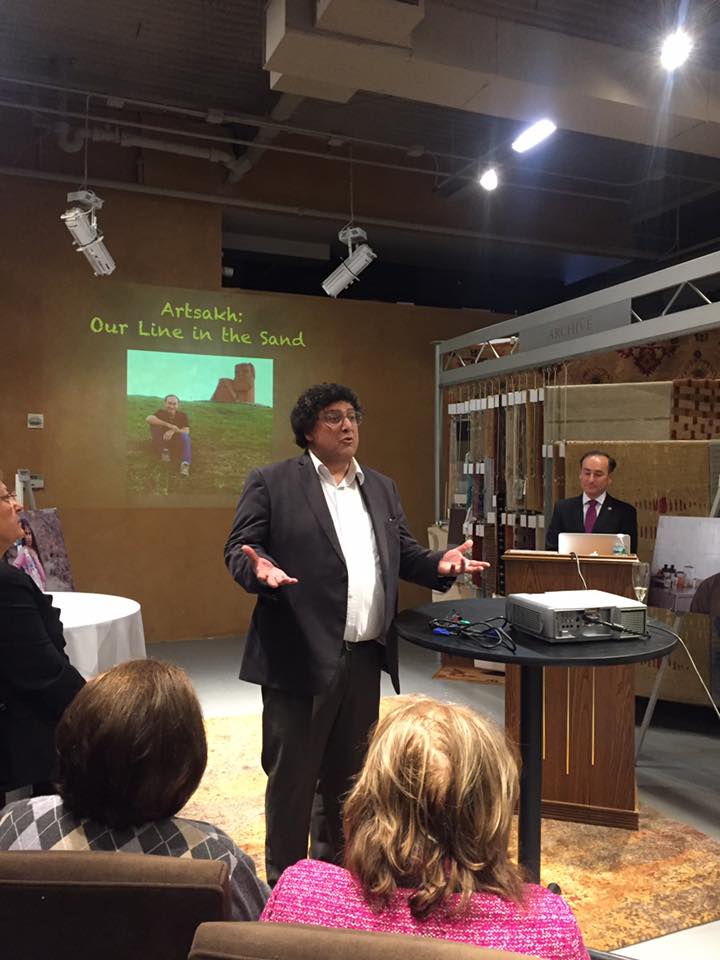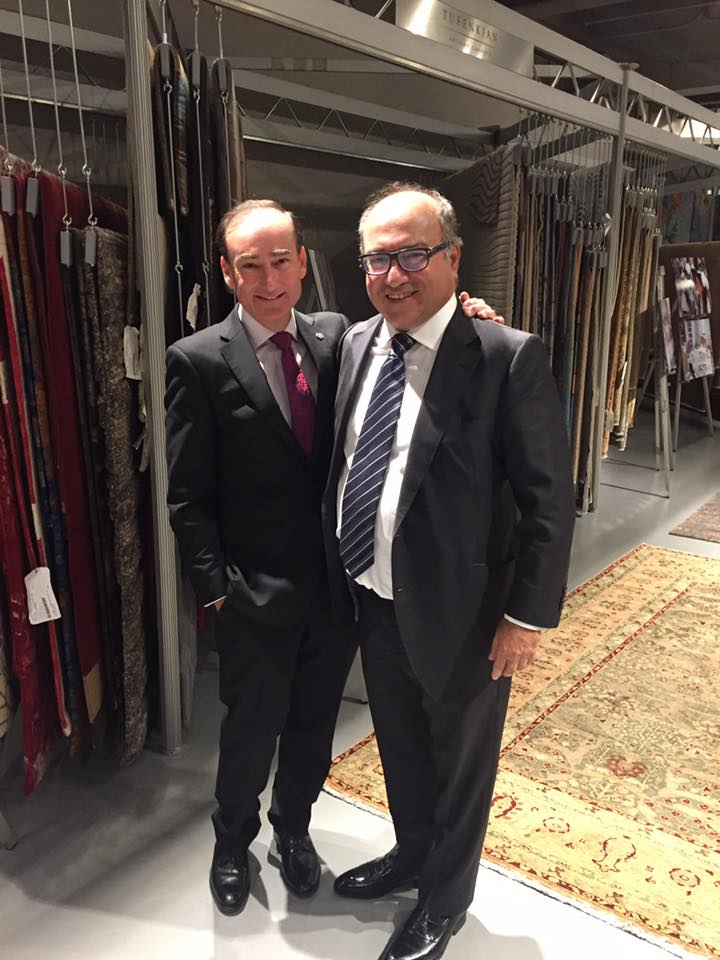Begins Second Century of Service in the Homeland
The Knights of Vartan Inc., currently celebrating its 100th anniversary, has extended its base of operations in the United States to Yerevan, Armenia by opening its Communications Office in Yerevan on Sept. 19 in a newly renovated office in the Tigran Metz Publishing building in central Yerevan.

Knights and Daughters of Vartan leadership with the Minister to the Diaspora The Hon Hranush Hakobyan (4th from L). (L to R) Past Grand Commanders Bob Barsam and Nigohos Atinizian; Asbed Father Dajad Davidian; Miniter Hakobyan; Grand Commander Steve Kradjian, Grand Matron Sona Manuelian, Past Grand Commander Haig Deranian, Grnad Vice Commander Hunan Arshakian, Past Commander Hirant Gulian, Past Matron Eva Medzorian and Past Commander Dr. Jack Medzorian; Past Commander Dikran Sahakian.
Established in Philadelphia in 1916 during the Armenian Genocide, the Knights of Vartan in July of this year declared “Veradardz Hayrenik” (“Back to the Homeland”) as the focus of its 2nd century of service.
Knights of Vartan Grand Commander Steven Kradjian, accompanied by Daughters of Vartan Grand Matron Sona Manuelian, led a delegation of 31 members of the Knights to Armenia, representing a majority of the lodges in North America, and 12 members of the Daughters of Vartan, to launch the Knights of Vartan Communications Office and conduct site visits to partners in service to the people of Armenia.
The Knights of Vartan Communications Office, Yerevan
The Communications Office in Tigran Metz will be staffed by a full-time Knights of Vartan Liaison, who will manage in-country communications on multiple media platforms, reporting to Grand Commander Kradjian. The Liaison in the Communications Office will facilitate and monitor collaborations of the Knights with its partners, manage Knights of Vartan publications, and will facilitate program planning and supervise implementation. Formal policies and written procedures enable the Communications Office to maintain continuity throughout the initial 5-year term, with up to three extension options as authorized by the Knights of Vartan supreme body in July 2016.
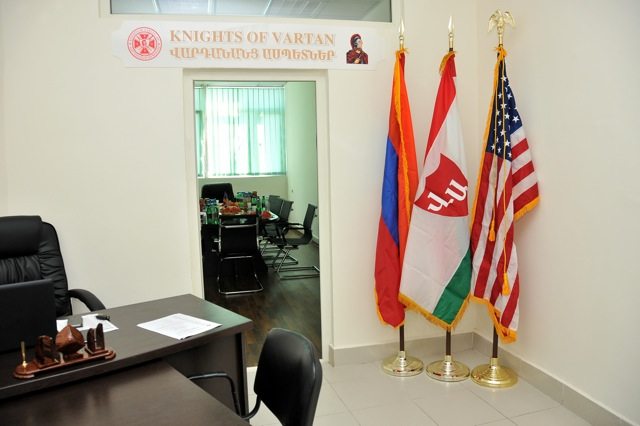
The new Knights of Vartan Communications Office in Yerevan
When Grand Commander Kradjian visited His Holiness Karekin II in Oct. 2015 at Holy Etchmiadzin to present a commissioned painting commemorating the Centennial of the Sainted Martyrs of the Armenian Genocide, the Knights of Vartan was contacted by the office of Hon. Hranush Hakobyan, Minister to the Diaspora, who invited the Knights national leadership to make an official visit to the Ministry. At that official visit on Oct. 2, 2015, Minister Hakobyan encouraged that in its Centennial year, the Knights of Vartan should convene a meeting in Yerevan and increase its presence in Armenia. Grand Commander Kradjian pledged to His Holiness and to Minister Hakobyan that the Knights of Vartan would return to Armenia in 2016 to convene a special meeting during its 100th anniversary year.
On July 9, the Knights of Vartan supreme body delivered and funded a mandate to establish the Knights of Vartan Communications Office and a permanent presence in Yerevan.
The Knights and Daughters of Vartan delegation visited Holy Etchmiadzin on Sept. 18, where His Holiness Karekin II received several members of the delegation in his office where he welcomed the Knights of Vartan to Armenia and gave them his blessing.
After opening the Communications Office on Sept. 19, the Knights convened an official delegates’ meeting on Sept. 20 at the Marriott Armenia Hotel, where Grand Commander Kradjian marked the start of Knights of Vartan operations in Armenia.

Knights of Vartan national leadership present and past at the Armenian Genocide Monument.
“For most of the past one hundred years, the Knights of Vartan has provided community leadership and support quietly, drawing no attention to its work,” Kradjian noted. “The 25thanniversary of the Independence of the Republic of Armenia and the centennial of the Knights of Vartan mark the time to expand our operations in Armenia, establish networks, partnerships and resource channels in Armenia for the greater benefit of our people,” he added.
Grand Matron Sona Manuelian also led a delegation of Daughters of Vartan in support of the Knights of Vartan’s historic expansion. Grand Commander Kradjian announced that the Daughters of Vartan are invited and welcome to utilize the Communications Office ad libitum.
Hundredth Anniversary Celebration
A formal 100th Anniversary Celebration for the Knights of Vartan was organized on Sept.19 by the Minister of the Diaspora, Hranush Hakobyan, at the Komitas Kamerayin Institute. Hundreds of guests attended, representing the Government, Clergy, and virtually all NGOs in Armenia. Minister Hakobyan presented the President’s “Movses Khorenatsi” Medal to Past Commander Hirant Gulian for his service to the Republic; and Commemorative Medals of the Speaker of the Armenian National Assembly to Past Grand Commanders Robert Barsam, Bob DerMatoian, Haig Deranian, Nigoghos Atinizian, and Past Commander Jack Medzorian and Past Matron Eva Medzorian; and the Boghos Noubar Medal of the Ministry of the Diaspora to Commander Leo Manuelian, Commander Tigran Sahakyan and Past Commander Ari Minnetyan. Father Dajad Davidian was awarded with the joined Hakob Meghapart Medal of the Ministry of the Diaspora and the Mekhitarist Congregation in Venice.

Grand Matron Sona Manuelian (left of floral) and members of the Daughters of Vartan delegation
Grand Commander Steven Kradjian and Lieutenant Grand Commander Hunan Arshakian were awarded the Special Medal of Patriotism for their leadership in establishing the Knights of Vartan in Armenia. Grand Commander Kradjian presented to Minister Hakobyan the Knights of Vartan Award in gratitude for successful collaboration in service to the Armenian people.
A Century of Service
Throughout the past century, the Knights of Vartan through several of its members and chapters across the United States have provided humanitarian aid to Armenian communities in vulnerable regions.
For the last two decades, for example, the Knights of Vartan has partnered with the World Bank Armenian Social Investment Fund and the Armenian Territory Development Fund who, with funds leveraged up to 19-to-1 dollars raised, have provided repairs and renovations to 235 schools in Armenia; with the Armenian Church Eastern Diocese through the Children of Armenia Sponsorship Program (CASP); with the Fuller Center for Housing in Armenia; with NAASR through the Knights of Vartan Fund for Armenian Studies, and other programs. As these programs are expanding annually, the need for a base of communications in Armenia became apparent. For this reason, the delegation made a number of visits to Knights-supported programs.
Fuller Center for Housing, Armenia
During this visit, the Fuller Center for Housing in Armenia announced the completion of a house for the 7-member Toroyan family in Geghashen, Kotyak Province, a home which was sponsored by the Knights of Vartan. Commander Leo Manuelian and Grand Matron Sona Manuelian for several years have been managing the Fuller Center’s partnership with the Knights and Daughters of Vartan.
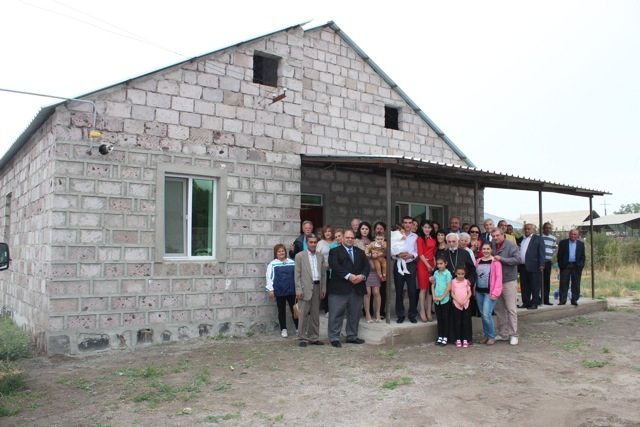
At the Fuller Center for Housing Armenia newly built home supported by the Knights and Daughters.
Grand Matron Manuelian and Grand Commander Kradjian attended the Toroyan house blessing on Sept. 22, celebrated by Fr. Dajad Davidian, a 55-year member Knight, in a moving ceremony. The Toroyan family received a supervised microloan to pay for materials needed to complete the building of their home over one year. Under this program, the family will repay the Fuller Center the microloan interest-free and inflation-free over 30 years, while local tradesmen volunteer their time and labor to help complete the home. The re-paid money will be recycled to support another housing project in a similar way, thus expanding the fund at a time when the housing need in villages remains extensive. The program grows over time, such that currently the Fuller Center for Housing in Armenia, led by President Ashot Yeghiazaryan, with colleagues Alla Asatryan and Rouzanna Sakanyan, completes approximately 100 family homes per year in regions throughout Armenia. The housing need is great, and the Knights and Daughters of Vartan contribute to fulfilling that need.
Knights of Vartan Sports Complex, Tavush
In the Tavush region, the Knights of Vartan Sport Complex was opened on Sept. 22 and consecrated under the auspices of Archbishop Bagrad Galsdanyan, the Minister of Sport, Hon. Gabriel Ghazaryan, Fr. Aram Mirzoyan of St. Hovhannes Church in Berd, and Father Armen. The complex including gymnasium, two soccer fields, pool, playground and state of the art utilities and fixtures, was personally financed by Commander Tigran Sahakyan, his family and Mamigonian Lodge of New York; construction is being supervised by staff of the Ministry of Sport. In addition, on recommendation of Commander Tigran, Grand Commander Kradjian awarded the Knights of Vartan Medal “For extraordinary service to the Armenian people in the name of the Knights of Vartan” to Minister Ghazaryan, Mr. Hayk Khookasyan, and Mr. Armen Zaimcyan, for all of their assistance on the project. On the sports complex property is also a 20-foot tall khatchkar, consecrated with the complex. It features the cross in the form of a sword of General Vartan, his strong and brave image and the cross boldly facing Azerbaijan across the border only a few hundred yards away
New Armenian Monument, Koghb
In the border village of Koghb, a crossroads which was the site of several car accidents, was redesigned and constructed by the Atinizian family to incorporate a new roundabout and monument of Armenian History for the town in the name of the Knights of Vartan. The new roundabout was the scene of an assembly by the entire village community, including students released from school for one hour to attend this opening ceremony, teachers, clergy and business leaders. Grand Commander Steve Kradjian addressed the assembly and conferred on Mr. Kevork Atinizian the Knights of Vartan Award for extraordinary service to the Armenian people in the name of the Knights of Vartan. Archbishop Galsdanyan consecrated the roundabout and monument on Sept. 22. Past Commander Arman Izmirlian and his wife Seta pledged to the assembled town leaders that he would improve the decaying bus stop adjacent to the roundabout, extending the service to the village in the name of the Knights of Vartan.
Children of Armenia Sponsorship Program (CASP)
The CASP program partnered with the Knights of Vartan serves orphans of the border region, and is led by Fr. Aram of the St. Steven’s Church in Berd. The Knights and Daughters of Vartan delegation visited the Church and met briefly with the children and the ministry staff. Filmmaker and member Knight Paul Boghosian commented on the significance of the Knights of Vartan expansion of operations in Armenia, emotionally describing the great unmet needs of children and families especially in these border regions; he exhorted that “As members of the Knights of Vartan we all must do our best to safeguard and improve these young Armenian lives.”
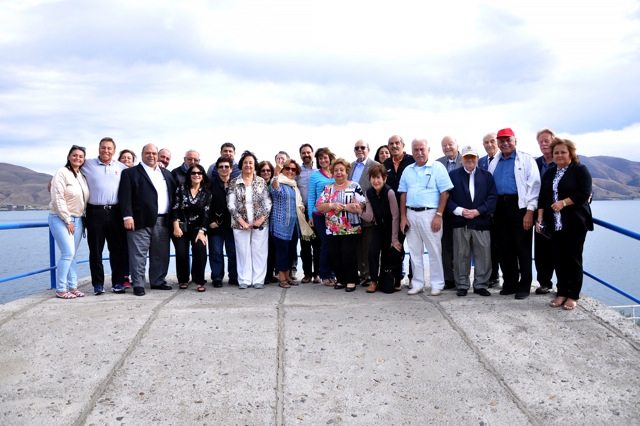
The delegation
The Knights of Vartan School, Yerevan
The Knights of Vartan since 1993 has supported the school in Yerevan now officially known as the Knights of Vartan School, serving Kindergarten through ninth grade. It is one of the many schools the Knights of Vartan has supported via its partnership with the World Bank Armenian Social Investment Fund and the Armenian Territory Development Fund. Students at this school have achieved the highest standards of learning in all academic subjects, particularly excelling in mathematics and physical science.
Over the years the school has expanded and improved its space, now serving 980 students. The Knights of Vartan delegation witnessed fully modernized classrooms and other classrooms and facilities in clear need of repair, requiring lighting, basic classroom furniture, and repair of stairs, and floors. An auditorium used by students more often than weekly has only natural light through high windows at the right time of day, and stadium style seating with splintered broken wooden chairs. Member Knight Dr. Garry Zamanigian committed to fund the installation of lighting in the auditorium at the Knights of Vartan School.
Looking Ahead
The Knights of Vartan humanitarian activities during the short period of September 18-24 illustrate a small example of the dedication and communication required of the Knights of Vartan Communications Office to fulfill the delivery of needed aid throughout Armenia, as they enter their second Century of the Knights of Vartan. Menk Veradardzank Hayrenik.
The Knights of Vartan is an Armenian fraternal service organization established by twelve visionary men to encourage its members to assume leadership roles in cultural, educational, religious, and charitable organizations and activities on the local, national and international level for the betterment of the Armenian nation worldwide. For more information, visit www.kofv.org.
















